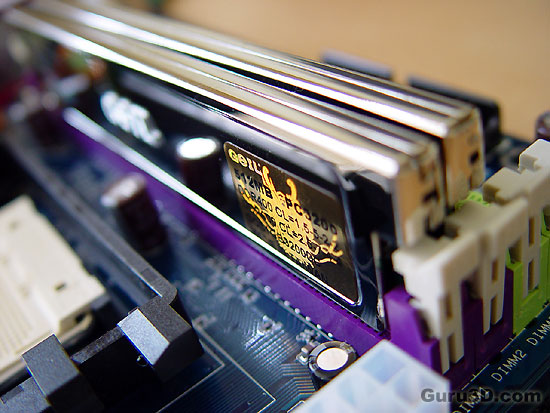Page 5
Things that make you go hmmm...
What will be very interesting to see in our benchmarks is that a DDR frequency of 400 and fast memory timings, in-game, roughly performs the same as that same bar of memory when clocked faster at 500 MHz but with slower timings. This pretty much explains the essence of timings. So the fastest memory frequency versus the faster memory timings would be optimal.
The only thing we did was change the memory frequency. Of course increasing the FSB will have an impact on performance as you start overclocking the rest of the system, along with the CPU being the two most essential factors.
In short, I'd opt low latency PC3200 memory over high speed DDR with a high latency memory any day!
The many possibilities of Tweaking
There are many ways to tweak/overclock memory let me explain a few techniques that we used today.
1) Altering memory timings.
By increasing memory voltage you usually can get better results from your memory. The Jedec standard for this type memory is 2.6 volts. Trust me, 2.7 or 2.8 will never be an issue. Now try and lower your memory timings. We'll do exactly that in the tests we run. Thus show you performance based on the same memory frequency yet with different timings.
2) Just playing around with a memory divider
You are basically limited to your mainboard tweaking options when it comes to BIOS settings.
If your mainboard supports it, then often you'll find options to run your memory at a faster or slower frequency. The mainboard used for our test today allows DDR 400 and 500 (2x250) MHz operations.
Anyway, we settled for a 250 MHz DDR frequency where we still where able to maintain 2.5:6:3:3 1T timings. Our voltage level was steady at 2.9 volts. A rather intense 2:5:2:2 1T @ 250 MHz however resulted in a reset during boot. Ah well, you can't blame me for trying can't you? But let's pump 3 volts into the memory, hmm still no go. Ah, 2:6:3:3 1... it boots!
We'll show you that the memory divider overclocks hardly had an effect.
The above two tweaking solutions we will apply in today's testing. To see what performance differences we are able to get based purely on memory timings and frequency yet with that CPU in all cases at 2800 MHz. We'll also do the following, step 3.
3) Raising the FSB yet stay at 2800 Mhz
The most performance you'll get from your memory is when you actually overclock your PC. In our case we used an thousand dollar FX-57 which quite honestly is (and pardon my language) a bitch to overclock. It's default clock is 2800 MHz and we barely got 3000 MHz out of it.
Can we still push the memory higher then? Yes once we lower the CPU multiplier to 12, give the CPU a little more voltage and then raise the FSB towards 235 MHz the results should be more promising for sure. By lowering the CPU multiplier and increasing the FSB we can still test at 2800 MHz, yet with faster clocked memory. With the nifty CAS 2 timing we'd had a memory bandwidth of 7000 MB/sec measured in Sandra. Nice !
4) Raising the FSB and pass that 2800 Mhz
Step four is however the end-result for most of you. After trying step 1 to 3 we now know exactly what the memory can handle for it's frequency and timings. But the best performance is obtained once we achieve a higher clock frequency on both the memory and processor. We set the CPU Multiplier at 14 and raised the FSB towards 211 MHz. Now that doesn't look like much of an overclock, but for an Athlon FX-57 it's quite daring. The CPU now runs at 2954 MHz and the memory at the sharpest possible timings which was 2:6:3:3 with a T1 command rate. In the following pages you'll notice a sharp peak in performance, this is what happens when you have everything right in your PC and tweak/overclock the entire system.

